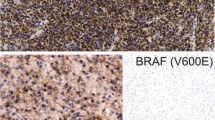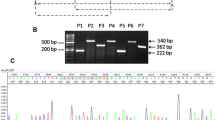Abstract
Low grade astrocytomas are the most common brain tumor in children. Recent studies have identified alterations in the BRAF serine/threonine kinase gene that result in mitogen activated protein kinase pathway activation. Herewith, we investigated the genetic changes of BRAF in pediatric low grade gliomas and their relation to pathological findings and Ki-67 proliferation index. The results showed gene fusions between KIAA1549 and BRAF in 66.7 % of tumors. The majority involved the KIAA1549–BRAF exon 16-exon 9 variant. Fusion junction between KIAA1549 exon 15 and BRAF exon 9 was found in five tumors, in which the myxoid component was the predominant. This has not been previously reported. No significant correlation was found between specific KIAA1549 and BRAF fusion junctions and Ki-67 index. All of the samples included in this study were tested for the presence of the BRAFV600E mutation, and no positive sample was found.

Similar content being viewed by others
References
Alexiou GA, Moschovi M, Stefanaki K et al (2011) Epidemiology of pediatric brain tumors in Greece (1991–2008). Experience from the Agia Sofia Children’s Hospital. Cent Eur Neurosurg 72:1–4
Lin A, Rodriguez FJ, Karajannis MA et al (2012) BRAF alterations in primary glial and glioneuronal neoplasms of the central nervous system with identification of 2 novel KIAA1549–BRAF fusion variants. J Neuropathol Exp Neurol 71:66–72
Cin H, Meyer C, Herr R et al (2011) Oncogenic FAM131B-BRAF fusion resulting from 7q34 deletion comprises an alternative mechanism of MAPK pathway activation in pilocytic astrocytoma. Acta Neuropathol 121:763–774
Tihan T, Ersen A, Qaddoumi I et al (2012) Pathologic characteristics of pediatric intracranial pilocytic astrocytomas and their impact on outcome in 3 countries: a multi-institutional study. Am J Surg Pathol 36:43–55
Jones DT, Kocialkowski S, Liu L et al (2008) Tandem duplication producing a novel oncogenic BRAF fusion gene defines the majority of pilocytic astrocytomas. Cancer Res 68:8673–8677
Dahse R, Kromeyer-Hauschid K, Berndt A et al (2009) No incidence of BRAF mutations in salivary gland carcinomas: implications for anti-EGFR therapies. J Biomed Biotechnol 2009:501736
Louis DN, Ohgaki H, Wiestler OD et al (2007) The 2007 WHO Classification of Tumours of the Central Nervous System. Acta Neuropathol 114:97–109
Horbinski C, Hamilton RL, Nikiforov Y et al (2010) Association of molecular alterations, including BRAF, with biology and outcome in pilocytic astrocytomas. Acta Neuropathol 119:641–649
Horbinski C, Hamilton RL, Lovell C, Burnham J, Pollack IF (2010) Impact of morphology, MIB-1, p53 and MGMT on outcome in pilocytic astrocytomas. Brain Pathol 20:581–588
Komotar RJ, Mocco J, Jones JE, Zacharia BE, Tihan T, Feldstein NA et al (2005) Pilomyxoid astrocytoma: diagnosis, prognosis, and management. Neurosurg Focus 18:E7
Fisher PG, Tihan T, Goldthwaite PT et al (2008) Outcome analysis of childhood low-grade astrocytomas. Pediatr Blood Cancer 51:245–250
Turner CD, Chordas CA, Liptak CC et al (2009) Medical, psychological, cognitive and educational late-effects in pediatric low-grade glioma survivors treated with surgery only. Pediatr Blood Cancer 53:417–423
Dienstmann R, Tabernero J (2011) BRAF as a target for cancer therapy. Anticancer Agents Med Chem 11:285–295
Bar EE, Lin A, Tihan T et al (2008) Frequent gains at chromosome 7q34 involving BRAF in pilocytic astrocytoma. J Neuropathol Exp Neurol 67:878–887
Jones DT, Gronych J, Lichter P et al (2012) MAPK pathway activation in pilocytic astrocytoma. Cell Mol Life Sci 69:1799–1811
Jacob K, Albrecht S, Sollier C et al (2009) Duplication of 7q34 is specific to juvenile pilocytic astrocytomas and a hallmark of cerebellar and optic pathway tumours. Br J Cancer 101:722–733
Forshew T, Tatevossian RG, Lawson AR et al (2009) Activation of the ERK/MAPK pathway: a signature genetic defect in posterior fossa pilocytic astrocytomas. J Pathol 218:172–181
Yu J, Deshmukh H, Gutmann RJ, Emnett RJ, Rodriguez FJ, Watson MA, Nagarajan R, Gutmann DH (2009) Alterations of BRAF and HIPK2 loci predominate in sporadic pilocytic astrocytoma. Neurology 73:1526–1531
Tatevossian RG, Lawson AR, Forshew T et al (2010) MAPK pathway activation and the origins of pediatric low-grade astrocytomas. J Cell Physiol 222:509–514
Horbinski C, Nikiforova MN, Hagenkord JM, Hamilton RL, Pollack IF (2012) Interplay among BRAF, p16, p53, and MIB1 in pediatric low-grade gliomas. Neuro Oncol 14:777–789
Chappé C, Padovani L, Scavarda D, Forest F, Nanni-Metellus I, Loundou A, Mercurio S, Fina F, Lena G, Colin C, Figarella-Branger D (2013) Dysembryoplastic Neuroepithelial Tumors share with Pleomorphic Xanthoastrocytomas and Gangliogliomas BRAF(V600E) mutation and expression. Brain Pathol. doi:10.1111/bpa.12048
Hawkins C, Walker E, Mohamed N et al (2011) BRAF-KIAA1549 fusion predicts better clinical outcome in pediatric low-grade astrocytoma. Clin Cancer Res 17:4790–4798
Jones DT, Kocialkowski S, Liu L et al (2009) Oncogenic RAF1 rearrangement and a novel BRAF mutation as alternatives to KIAA1549–BRAF fusion in activating the MAPK pathway in pilocytic astrocytoma. Oncogene 28:2119–2123
Tian Y, Rich BE, Vena N et al (2011) Detection of KIAA1549–BRAF fusion transcripts in formalin-fixed paraffin-embedded pediatric low-grade gliomas. J Mol Diagn 13:669–677
Pfister S, Janzarik WG, Remke M et al (2008) BRAF gene duplication constitutes a mechanism of MAPK pathway activation in low-grade astrocytomas. J Clin Invest 118:1739–1749
Author information
Authors and Affiliations
Corresponding author
Rights and permissions
About this article
Cite this article
Dimitriadis, E., Alexiou, G.A., Tsotsou, P. et al. BRAF alterations in pediatric low grade gliomas and mixed neuronal–glial tumors. J Neurooncol 113, 353–358 (2013). https://doi.org/10.1007/s11060-013-1131-5
Received:
Accepted:
Published:
Issue Date:
DOI: https://doi.org/10.1007/s11060-013-1131-5




